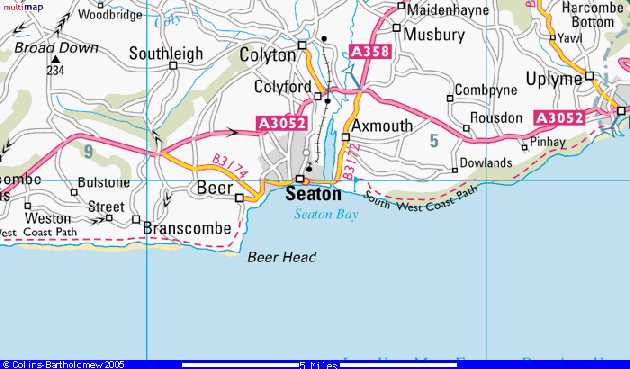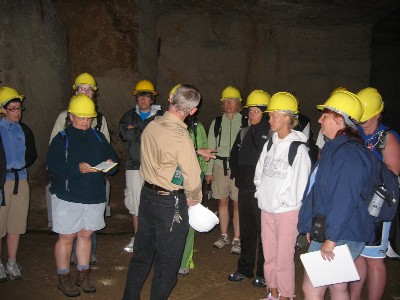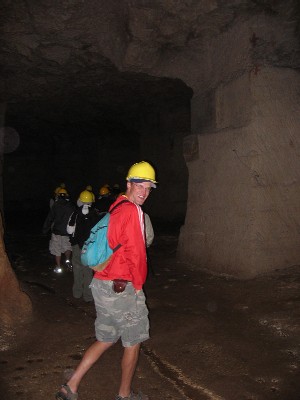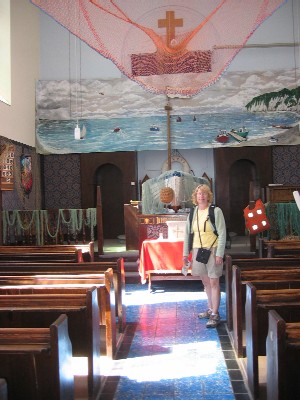The Real Jurassic Park: Geological Explorations in Southwest England
University of Washington, Tacoma
TESC 417: Summer 2006
The Real Jurassic Park: Geology field course along the south coast of England (TESC 417)
Home
Location: Beer and Seaton
Introduction:
August 3, 2006--Thursday morning we were headed for the Beer Caves, Seaton and Sidmouth. Our activities for the day were to visit the Beer Quarry Caves,
located in East Devon, and to view the Seaton cliffs. From there we would drive to Sidmouth, which was west of Beer. Our topic of study in Beer
was mining and economic geology. In Sidmouth we looked at the sedimentology and stratigraphy.
Detail Map:

Highlights:
Beer--The Beer Quarry Caves are located just behind the village of Beer close to the coast. We were lucky to have a very knowledgable and enthusiastic
tour guide who made the caves come alive, allowing us a clear look at life back in the 1800's. The layer of Chalk, which is known as Beer Stone, is composed of very densely
packed and minute shell fragments and is a quality masonry stone that has been quarried since the Roman times. The quarrying has created the caves which cover an
area equivalent to fifty football fields and has a 2,000 year history of quarrying stone using virtually unchanged methods from the Roman times until the last century.
(Brunsden, 32)
Seaton--Our topics for Seaton were to study the Seaton fault and the cliffs, which were fascinating natural scupltures in a soft red stone and beautiful to look at against the blue sea..
 Descent into the Beer Caves
Descent into the Beer Caves
 Seaton--fault with chalk next to red beds
Seaton--fault with chalk next to red beds
Synopsis of Area:
Beer--The Beer Stone rocks formed in shallow sub-tropical seas that covered Dorset and East Devon in the Cretaceous age, some 70 million years ago.
Although most of the Chalk in the area has eroded, a quirk of geology has preserved the Chalk in Beer. This quirk is that the Chalk rocks are faulted and
folded downwards. They are level with the older rocks and therefore protected from erosion. The Chalk contains very distinctive bands of flint.
Beer Stone has been used in some very famous buildings in England including The Tower of London, Exeter Cathedral, Westminister Abbey, St. Paul's Cathedral and Winchester Cathedral.
Seaton--East of Beer is the town of Seaton where there is, in striking contrast to Beer, the red Mercia Mudstone of Triassic desert origin. The red mudstones found at Seaton
also occur to the west of Beer at Branscombe where they crop out beneath the Cretaceous Chalk. Going farther west, near Sidmouth, Triassic red-beds occupy most of the cliffs.
At Seaton Hole, a fault with a throw of about 60 metres, brings up Triassic Mercia Mudstone on the east side. It is mud and desert from the
interior of a "Sahara Desert" of about 250 million years ago. At that time the British region was at a latitude about that of the modern Sahara desert. In the region there
are deposits of gypsum in the Mercia Mudstone and pseudomorphs or natural casts of halite crystals have been found. The red desert mudstone has green (reduced)
bands in it. They are displaced by numerous small faults. In some places there are also green reduction spots." (West)

Writings on Beer Stone by quarrymen. Quarrymen, who were not as skilled as the stone masons, roughly signed their names to the stone they cut while masons would carefully incise their signature and personal details into the stone.
Summary:
Beer--Our guide, John Scott, did a superb job of taking us back in time. He told amazing stories of local quarrymen who worked below ground some 200 feet
in appalling conditions for 14 hours a day. They risked their lives using basic tools to extract the stone. As we followed John and listened to his
stories, we relived history and gained a respect for the dangers of this underground environment. He told us an unnerving story of a overly
confidant tourist who was lost in the caves overnight in the cold and damp, unable to find his way out as it was pitch black. We all stayed very close to John after that.
Back in the days of quarrying, the caves were lit by a feeble light of tallow candles pressed into clay holders moulded to the rock. The quarrymen were allotted five candles per day.
Beer has primarily been a fishing and quarrying village, and women there have also made very fine handmade lace. However, there was a fourth industry that brought revenue into Beer
which was smuggling. The caves were used to hide the contraband. With our tour through the caves complete, we made a stop at the small shop for refreshments. John shared with us his authentic Roman coin that had been discovered
in the caves. It had been a fascinating morning and well worth our time. John Scott co-authored a book with Gladys Gray, Out of Darkness: A
Brief history and description of the Old Stone Quarry, Beer, which was a good read and had some good insider information. (Scott, 11)
We were now headed off to view the Seaton cliffs and then to see the Triassic rocks at Sidmouth.
Seaton--Seaton was a nice stop after visting the Beer Caves. The caves were wonderful but cold and damp and it was nice to be out in the fresh air. The cliffs of Seaton were
beautiful and we had a nice walk through the town. After learning about the Mercia Mudstone and Seaton Fault, we piled back into the van and headed
for Sidmouth where we would learn about sedimentology and stratigraphy and view the Triassic rocks of the area.
 Guided tour of the Beer Caves by a local expert and tour guide--John Scott
Guided tour of the Beer Caves by a local expert and tour guide--John Scott
 Gus in the Beer Caves
Gus in the Beer Caves
 Liz in a maritime church in Beer
Liz in a maritime church in Beer
Links to Related Projects:
The Cretaceous Chalk in Southern England. By Birenna Graham
The Romans in Britannia. By Alison Crouch
Geology, Landscapes, and Land Use of Dorset and East Devon. By Angus Leger
Holy Architecture!: Cathedrals, Abbeys, and Parish Churches of Southwest England. By Lisa Green
Geology and Tourism on the South England Coast. By Jenny Ripatti
Other Related Links:
Geology of the Wessex Coast, Southern England by Ian West
References and Acknowledgements:
-- Brunsden, Denys. The Official Guide to the Jurassic Coast, Dorset and East Devon Cost World Heritage Site. Coastal Publishing. Wareham, England, 2003.
-- Detail Map: 2006 Multimap.com. September 2, 2006. http://www.multimap.com
-- Dorset County Council (2006). Jurassic Coast. September 22, 2006. http://www.jurassiccoast.com/index.jsp
-- Scott, John. Out of Darkness. A brief history and descriptionh of the Old Stone Quarry, Beer.Axminster Printing Co. Ltd.
Home

 Descent into the Beer Caves
Descent into the Beer Caves
 Seaton--fault with chalk next to red beds
Seaton--fault with chalk next to red beds

 Guided tour of the Beer Caves by a local expert and tour guide--John Scott
Guided tour of the Beer Caves by a local expert and tour guide--John Scott
 Gus in the Beer Caves
Gus in the Beer Caves
 Liz in a maritime church in Beer
Liz in a maritime church in Beer